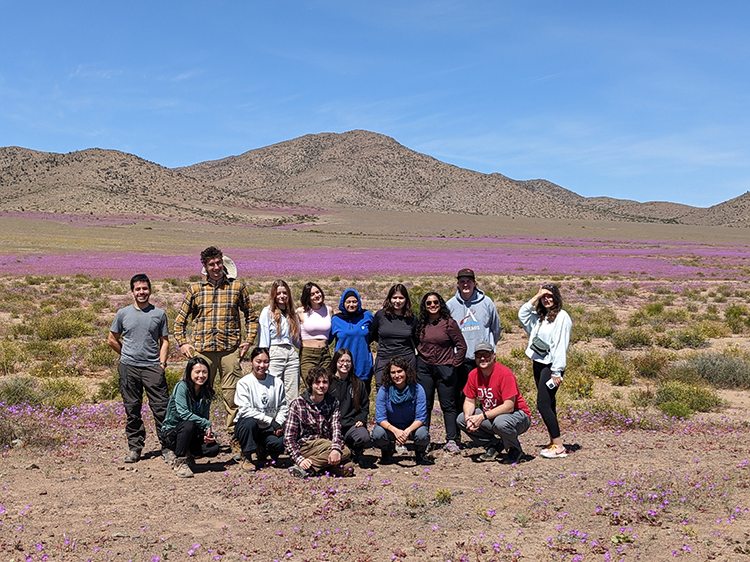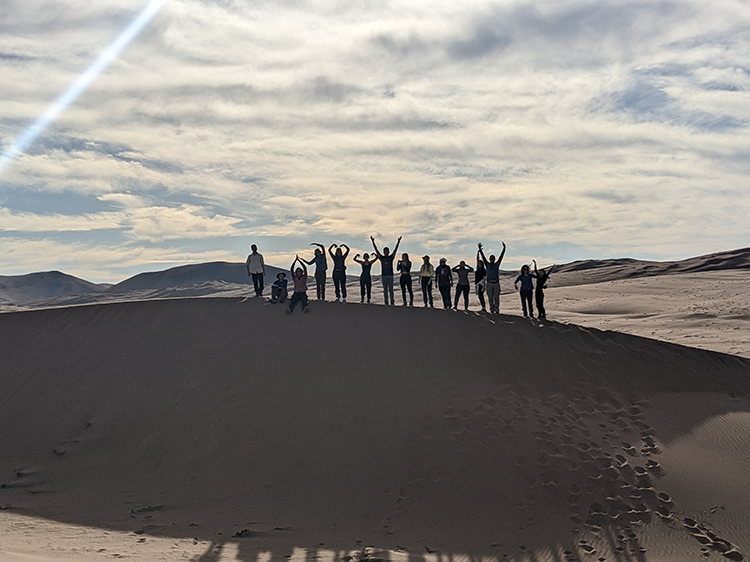While most travelers return home with mementoes like postcards and t-shirts, earth sciences professors Dan Gregory and Corliss Sio and their students returned from a trip to Chile with over 25 kilograms of rocks and minerals.
The “souvenirs” were collected during their International and Indigenous Course Module (IICM) trip late last year, part of Gregory’s fourth-year Mineral Deposits course and Sio’s third-year Igneous Petrology course.
“I brought back so many rocks!” says Daniel Giannotti, a fifth-year, New College student majoring in chemistry and geoscience. “When I was checking in for my return flight, the customs agent wanted to know what the giant lump in the x-ray of my bag was. He was a little shocked and kind of confused.”
The Faculty of Arts & Science’s IICM program provides undergraduate students with the opportunity to travel outside Toronto, often internationally, for a hands-on learning experience. For the earth sciences IICM, Gregory, Sio and 11 students spent nine days visiting geologically interesting sites and mining operations in Chile’s Atacama Desert. They were accompanied by Chilean U of T earth sciences PhD student, Nelson Roman Moraga and Universidad Austral de Chile earth sciences professor Irene del Real.

“Chile is a great location for students because geologically, the country is very different from Ontario,” says Gregory. “The rocks are geologically very young compared to those we find here. The country is a subduction zone where one tectonic plate is submerging beneath another. There are volcanoes, as well as mineral deposits that are very different from what we have here.”
In class, we can show them rocks, but they’re completely out of context. On a trip like this, students get to see real outcrops and get a sense of the true scale of things. The experience really puts what they learn in class into a physical context.
The trip provided students with an opportunity to go beyond the classroom and lab and see the geological formations, rocks and minerals they’d only read about before.
“In class, we can show them rocks, but they’re completely out of context,” says Sio. “On a trip like this, students get to see real outcrops and get a sense of the true scale of things. The experience really puts what they learn in class into a physical context.”
Says Gregory, “It’s so valuable for the students to be able to go to the top of a hill and look at a fault zone and actually see this feature that stretches for hundreds of kilometres.”
It was also a chance for them to see what it would be like to work as a geologist.
“They would just let us loose at some of the mine sites,” says Hannah Eaton-Tessier, a fourth-year Victoria College student pursuing majors in geoscience and ecology & evolutionary biology. “Everyone brought their rock hammers, and we climbed up this hill and were breaking rocks and finding cool crystals and minerals. I really enjoyed that.”
Chile is rich in iron, copper and gold and has a very strong mining sector. The group visited three mines: one an active, open pit mine, and two which were no longer operating. The different sites illustrated for the students the contrast between modern, less intrusive mining practices and more harmful, outdated practices. They also witnessed remediation efforts to repair the damaging effects of mining.

“It was a really cool opportunity — especially after COVID — to work in the field and, for me, to visit South America for the first time,” says Eaton-Tessier. “And we had a great group of people who’ve all become close friends who still hang out.”
“It was amazing,” says Giannotti. “I got to see some incredibly interesting stuff academically and culturally. I made great connections with classmates and professors and strengthened connections I already had.”
Like all IICMs, this one helped students chart their academic paths.
It was amazing. I got to see some incredibly interesting stuff academically and culturally. I made great connections with classmates and professors and strengthened connections I already had.
“Earlier in my undergrad, I was leaning more toward biology,” says Eaton-Tessier. “I was taking earth sciences more for fun and out of interest. But now, with this trip and with many of my friends leaning towards earth sciences, I’m definitely leaning more in that direction now.”
“I like both geoscience and chemistry and discovered that both are important in the extraction of minerals from rock,” says Giannotti. “And I heard on one of the mine tours about a system that uses a chemical polymer to extract sulfate minerals from the rest of the rock. I found that incredibly interesting. So, I'm really looking forward to learning more about that process. That would be something I’d have fun learning about and working on. And who knows, maybe someday, I can even improve the process.”
But the trip wasn’t just about academics. The professors and students learned about the country’s history from their Chilean colleagues, and they all experienced the country’s culture — including the food.
And in addition to rocks and minerals, they brought back memories they won’t soon forget — like an unscheduled stop to “surf” down a giant sand dune, viewing flocks of flamingos, and the sight of a rare blooming of wildflowers in the middle of one of the driest deserts on the planet.
“We couldn’t have chosen a better destination,” says Sio. “For some of the students, it was a once-in-a-lifetime experience.”

